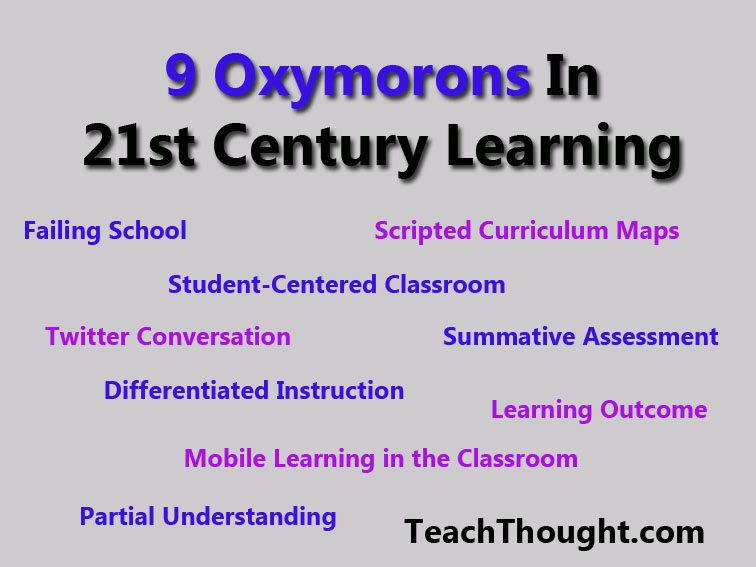9 Oxymorons In 21st Century Learning Vernacular
As 21st century teachers, we have to put up with a lot.
Constantly changing expectations. Move academic targets. Constant waves of new technology. Changing sources of professional development.
It certainly keeps one day from being the same as the next, but it also creates the opportunity for us to contradict ourselves. Well, not you specifically, but as an industry. And after awhile, our collective vernacular is piled high with oxymorons–or oxymoronish–phrases that need tending to.
Below are 9 playful examples.
1. Twitter Conversation
You can “@” with someone on twitter, and even exchange ideas 140 characters at a time, but that is not a conversation. Perhaps twittersation makes more sense.
2. Differentiated Instruction
Differentiated learning? Yes. Differentiated assessment? Sure.
Differentiated instruction? For 30+ students? Probably not.
3. Mobile Learning in the Classroom
If it’s truly mobile, it’s probably out in the community, in the form of project-based learning and place-based education, yes?
4. Scripted Curriculum Maps
A curriculum mapping is a flexible, living, breathing document that should change in response to, among other factors, learning results. If the curriculum is scripted from the beginning, it’s less of a curriculum map and more of a curriculum check-list.
5. Student-Centered Classroom
Of course, student-centered learning is possible. And it is also possible to create a classroom that is not teacher-centered. But to create a classroom “centered” towards 30+ students is a bit of stretch—but well-intended!
6. Partial Understanding
Having partial understanding is synonymous with the lights being partially on. They’re either on, or they’re not. As educators, the more specific we are with our language, the better. In this way, it’d be better to say “Can define and analyze, but struggles with application and evaluation” rather than “has partial understanding.”
Or worse, does or does not “get it.” Cringe!
7. Learning Outcome
I’m guessing that Grant Wiggins would strongly disagree with me here—and would probably be right—but the idea that we can sit down 6 weeks before an assessment and decide exactly what it is that the students will understand a month and a half later is a bit ambitious.
We can certainly choose topics, plan projects, build assessments, and even “cause understanding” in bits and pieces, but the likelihood that all of our instruction will cause the same understanding of a small handful of standards in every student is, well—again, it’s ambitious.
A student may never fully grasp the relationship between the structure of an essay and its purpose, but may have progressed leap years in their understanding of audience awareness throughout a unit designed around the former.
Being that the entire outcomes-based learning structure is predicated on this very fact means that we’ve gotten pretty good at it over the years. But nonetheless, when the assessment comes, instead of having an opportunity to prove what they do understand, the student above would likely “fail,” unable to demonstrate understanding of the chosen standard.
8. Failing School
Schools don’t fail–only our response, measurement instruments, buy-in, and expectations.
9. Summative Assessment
Since the only assessment we ever give that leads to nothing is the last assessment of a given school year, that is the only true summative assessment. In 2013, all work can be visible, curated, and constantly evaluated by a variety of stakeholders. The “end of a unit” doesn’t mean the end of the need for understanding if the content is truly worth understanding.
Long live formative and transformative assessment!

